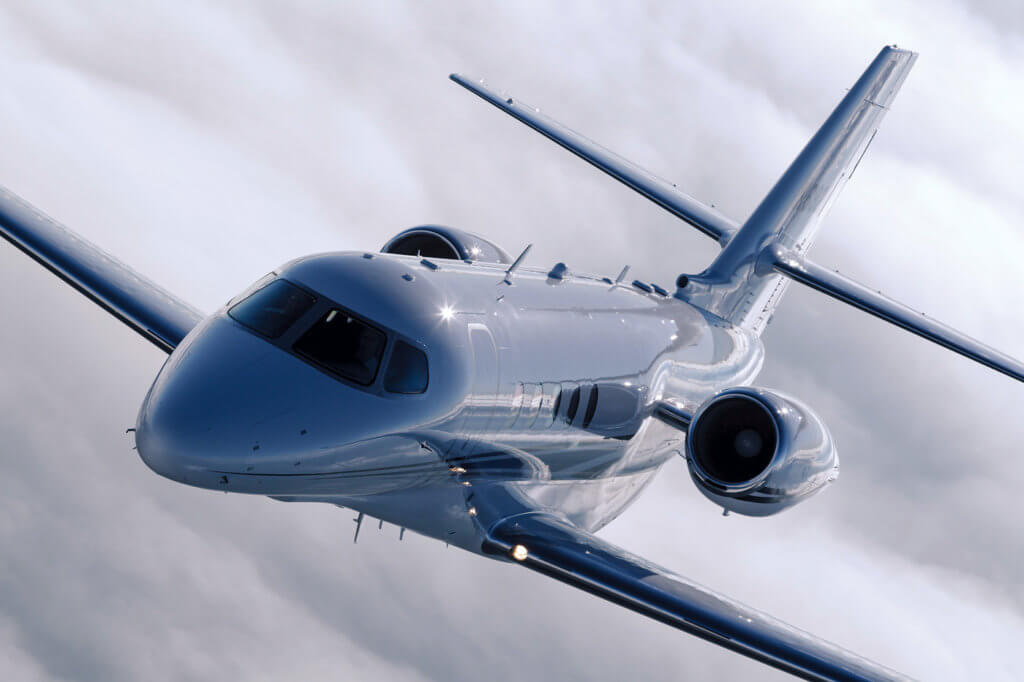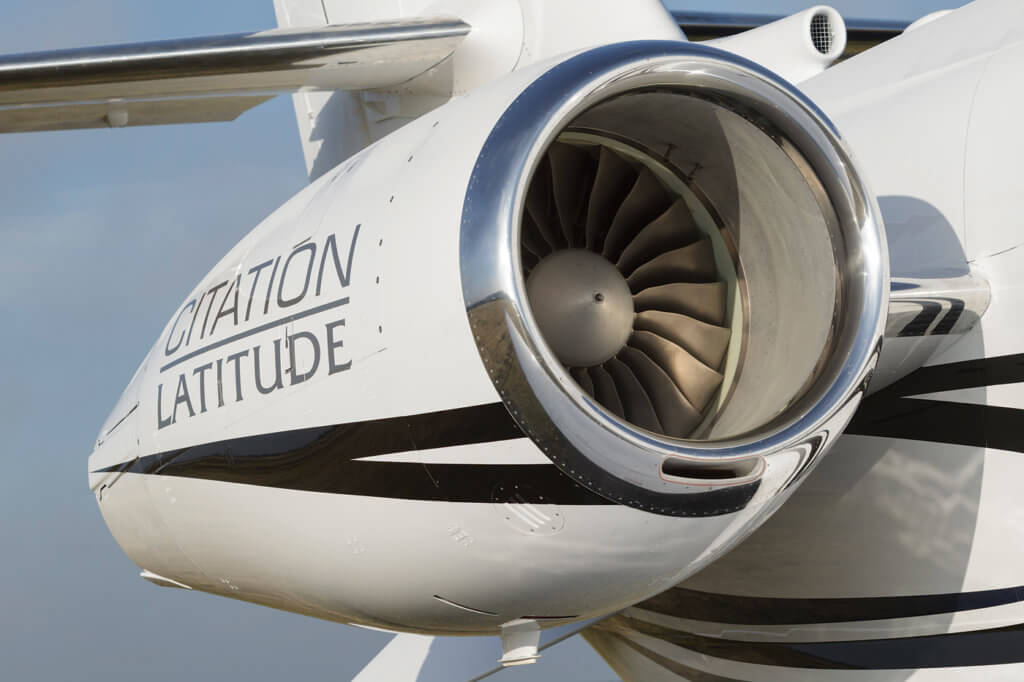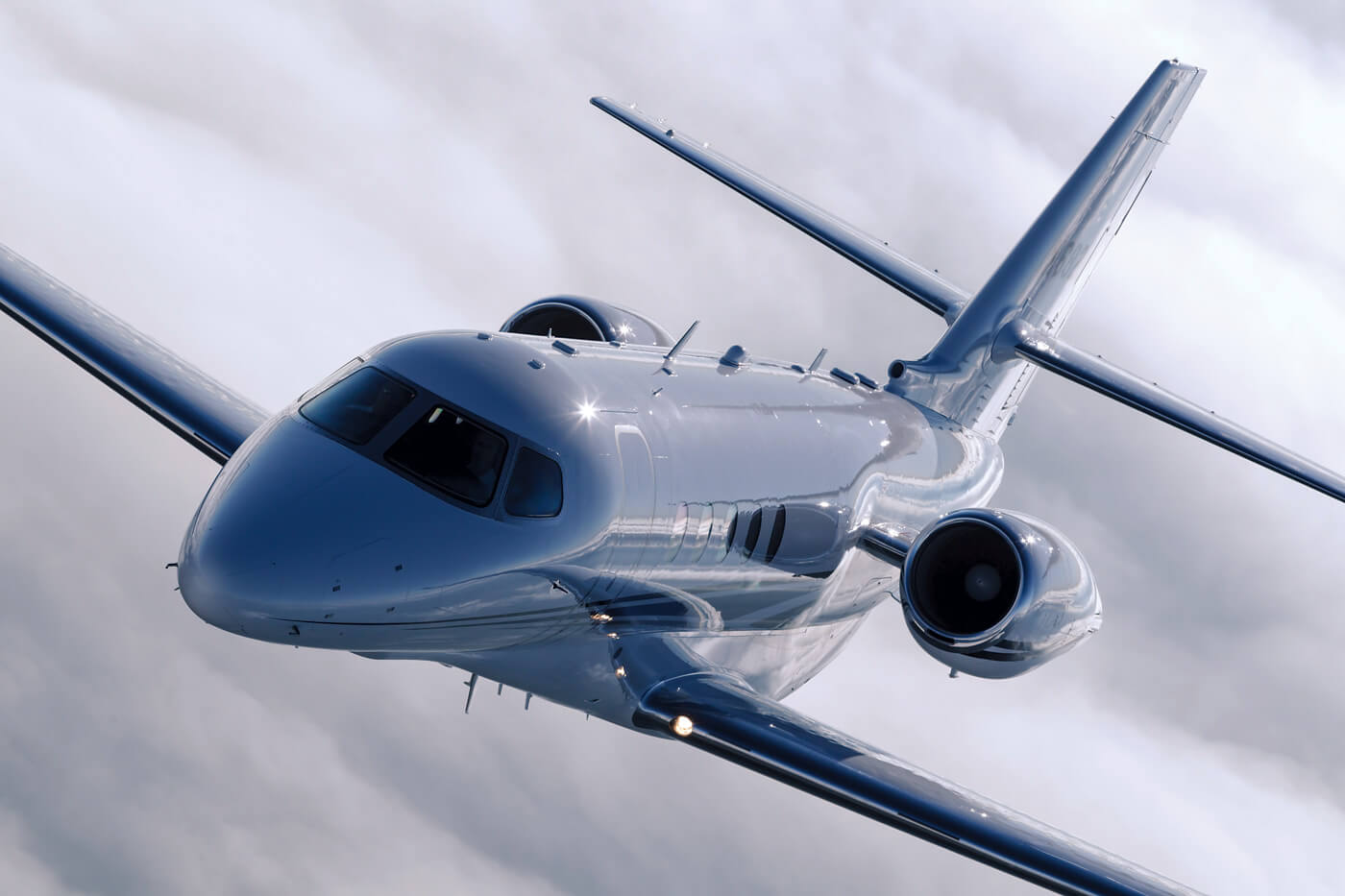Estimated reading time 10 minutes, 24 seconds.
The Cessna Citation Latitude plays tricks upon the eye. It is simultaneously a brand new airplane and an incremental development of previous Citation models. Both perspectives seemed true during Skies‘ evaluation of Cessna’s latest midsize jet. It manages to be a low-risk derivation of the Model 680 Sovereign, whilst offering passengers a travel experience that is unprecedented in previous Cessna midsize designs.

If you want to understand the Latitude in a sound bite, here goes: same great wing, new roomier fuselage. Anyone familiar with the Sovereign will immediately notice the Latitude’s new, spacious 77-inch-wide fuselage; Cessna’s first with a six-foot stand-up cabin and a flat floor. There are other changes, as we’ll see, but the Latitude is Cessna doing what they do best; building upon success.
I test flew Cessna’s then recently updated Sovereign+ in June 2014 and found it a capable, albeit modest, upgrade to an already successful midsize design. The more ambitious Latitude’s first flight was in February 2014. It was certified on June 5, 2015 as the Model 680A, under an amendment to the Model 680 Sovereign Type Certificate. Pilots trained on the Sovereign will only need differences training to fly the Latitude.
The Latitude uses the same terrific wing as the Sovereign, which is generously sized and mildly swept to balance off cruise and field performance. Generous flaps are another reason why a jet with a maximum operating Mach number (Mmo) of 0.80 Mach can have approach speeds below 100 knots.
Engineering design is the art of compromise. With so much wing, the Latitude is not the fastest jet in its class, but that’s offset by strong field performance which gives it access to more airports, and ultimately greater overall utility. In fact, the newer Latitude is about 10 knots slower than the Sovereign, but Cessna evidently thought the improved cabin volume to be more than a fair offset. After flying it, I’d agree.
MEET THE JET
Textron demonstration pilot Ken Mullins began my introduction to the Latitude with the pre-flight inspection. The demonstrator aircraft, N626LA, was well equipped, including optional automatic direction finder (ADF), high frequency (HF) receiver, Iridium satellite Internet, VHF datalink and XM weather.
The electrically-operated main door is another new feature on the Latitude, and provides a definite “Wow!” effect for passengers as it whooshes open in welcome. It can be operated manually as a back-up, and even includes a small gee whiz periscope to ensure that the ramp beneath is clear.

The Latitude retains the Sovereign’s enviable systems simplicity. The flight controls are mechanical and unboosted, with the exception of the five hydraulically-powered multifunction spoiler panels per wing. The ailerons incorporate speed-dependent gearing to keep control forces manageable. The flaps are electric. Delta fins are another visual indicator of the Latitude over the Sovereign, providing additional directional stability at high angles of attack.
As in the Sovereign, the Latitude sports a pair of high-bypass PW306D1 turbofan engines, with 5,907 pounds thrust, flat rated to ISA +15°C. The engines feature full-authority digital engine control (FADEC).
A further upgrade from the Sovereign is the 9.7 pounds per square inch cabin pressure differential which provides a 6,000 foot cabin altitude at the Latitude’s maximum certified ceiling of 45,000 feet.
The unheated and unpressurized baggage compartment will make any corporate co-pilot smile, incorporating stairs into the inside of the door to facilitate access to the furthest corners of its 100 cubic foot interior. No more fishing for luggage with a grappling hook!
The cockpit features the innovative and capable Garmin G5000 avionics suite. The interface to the G5000 is via the iPad-like Garmin Touch Controller (GTC). The Latitude features dual GTCs per pilot. In this configuration, each GTC is optimized for a different role, with the left unit controlling mainly the primary flight display (PFD), and the right reserved for the multi-function display (MFD). This arrangement minimizes burrowing in the page structure, and is the optimal configuration. I’ve raved about the G5000 before, so I’ll be concise this time: I love it! It’s easy to use, simple to operate, and inherently flexible enough to afford the pilot multiple ways to accomplish the same task.
As yet there is no integrated performance database, although Textron expects it to be available in the third quarter of 2016, including en route performance. In the meantime, Cessna offers a range of iPad apps for performance calculations, and although not integrated into the aircraft, they are eminently usable and convenient.
FLYING TO HIGH LATITUDES
I am always curious what will be my first impressions when settling into an unfamiliar aircraft. In the Latitude it was the spacious cockpit. There were acres of leg and elbow room, yet everything fell easily to reach.
Our jet’s basic empty weight was 18,372 pounds. Inclusive of 5,540 pounds of fuel, or roughly half of the 11,394 pound maximum fuel capacity, plus 768 pounds of crew and equipment, our ramp weight was 24,680 pounds. The Latitude’s maximum takeoff weight is 30,800 pounds.

Engine starting was push-button simple, thanks to the FADEC, and pre-flight systems checks were mercifully brief. Ground handling benefited from smooth carbon brakes and low idle thrust. With up to 88 degrees of nosewheel deflection available through the tiller, the Latitude can negotiate congested ramp space with ease. I found the tiller’s spring centering quite strong, but precise, and it was nice not to need the tiller in most cases. Nine degrees of nosewheel steering from rudder deflection allowed me to steer with my feet along the straightaways.
It was a sunny June day in Wichita, Kan., which means it was hot! Tower reported a temperature of 33 degrees Celsius and winds from 110 degrees at 10 knots as we taxied for Runway 19L. Using the iPad “app” for reference, Mullins determined that our “Flap 2” takeoff speeds were decision speed, V1 = 96 knots indicated airspeed (KIAS), rotation speed, VR = 99 KIAS and takeoff safety speed, V2 = 108 knots.
The autothrottle was something I appreciated in the Sovereign+, and it’ll prove just as popular in the Latitude. Garmin’s autothrottle implementation is elegantly simple. The throttle quadrant has only two stops, denoted “Idle” and “TO” (takeoff). The FADEC sets power adaptively, based upon phase of flight and elapsed time. Once aligned with the runway, the autothrottles detected my intention to go flying as I began to advance power, and the throttles moved themselves smartly to the takeoff (TO) detent.
Away we went! Field performance was a strength of the Sovereign+, and the Latitude was clearly a strong performer in that department, too. The required takeoff field length was only 3,066 feet, and that distance was covered quickly! Cessna quotes an impressive takeoff field length requirement of 3,580 feet under standard conditions and maximum takeoff weight.
I tracked the normal climb profile of 250 KIAS to 0.64 Mach. I didn’t need a stopwatch to know that the Latitude’s climb performance was exceptional. Initial indicated rates of climb were slightly over 4,000 feet per minute through 10,000 feet. We levelled at 41,000 feet (FL410) just 16 minutes after takeoff (under ISA +1C conditions), having burned about 850 pounds of fuel.
At FL410 I set a maximum cruise power setting and let the Latitude off leash. The result was 435 knots true airspeed (KTAS) (0.76 Mach), burning 1,600 pounds per hour total fuel flow (with 4,440 pounds fuel remaining, under ISA-2C conditions); performance slightly better than the “book.” Mullins offered that productive initial cruise altitudes are 40,000 to 41,000 feet at normal weights and conditions, and that a typically equipped aircraft will easily let you fill the seats with 10,000 pounds of fuel.
COMMODIOUS CABIN
As the Latitude gobbled up the miles, I ambled into the cabin to see how the other half lives. Textron demonstration pilot Ben Nofziger stirred from his plush repose to show me around. The stand-up cabin, flat floor and large windows make the Latitude immediately feel like more than a midsize jet.

The main cabin seating is a “club plus two” arrangement, with an additional seat or two-place divan across from the entry door, depending upon optional galley configuration. There is an additional belted seat in the lavatory. The centre seats swivel to “club” with either the forward or the aft pair. Each seat is individually able to cant, swivel and recline. The centre seats convert into nearly flat berths. There was storage space artfully concealed everywhere, including behind the pocket door within the spacious lavatory.
Nofziger demonstrated how the barrier curtain over the main cabin door served to reduce interior noise noticeably, especially in the forward cabin. We took seats at opposite ends of the fuselage, and could easily speak at conversational levels.
The Clairity in-flight entertainment system is becoming Cessna’s standard, and relies upon an iPad “app” as the interface to control lighting, cabin temperature, moving maps and an assortment of streaming media sources. The system’s sound quality was so good that I accidentally caught myself enjoying a sample of country music; something that usually causes me to break out in hives.
MEANWHILE, IN THE COCKPIT
As we began our descent, Mullins demonstrated one of the Latitude’s envelope protection features. We disengaged the autothrottles and commanded a steep descent using the autopilot’s vertical speed mode. As the speed passed through the 0.80 Mach Mmo the autothrottles engaged to reduce power, following which the aircraft pitched up to prevent overspeed. Mullins had me subsequently pull back the throttles and hold the nose up to stimulate the low-speed envelope protection features. As the airspeed entered the yellow range on the display, the autothrottles again engaged to shove forward the throttles to prevent stall. I’m always reassured when an aircraft participates in its flight limit protection.
I took a few minutes to sample the handling at low altitude. The large wing gives the Latitude a rather lively response to summertime Kansas convection. We performed a simulated circuit at around 8,000 feet, followed by a simulated dual-engine overshoot. Hand flying the Latitude was predictable and fun, albeit slightly heavy in roll. Configuration changes were easily managed, in part because of the slow response rate of the flaps.
We returned to Wichita via the RNAV Y approach to Runway 19L. With the autopilot and autothrottles coupled, there was little to do but watch and configure the jet for landing. The flight management system cued us to begin deploying flaps at 190 KIAS as we decelerated for a final approach reference speed (Vref) of 99 KIAS. The autothrottles were moderately busy dealing with convective turbulence; but then again, the approach was far more precise than I could have hand-flown it. At 50 feet the autothrottles retarded to idle; I awoke, flared and landed. The iPad told us that the required landing field length was 2,562 feet (3,200 pounds fuel, +33°C). It was easily achievable.
The magic of the Latitude is that by “upgrading” the Sovereign with a spacious new fuselage, Cessna has managed to create a completely new airplane. The fine balancing act of ample cruise speed and impressive field performance now includes a commodious super-midsize cabin. The Cessna Latitude strikes a fine balance indeed.
Robert Erdos is a contributing editor for Skies magazine. He is a professional test pilot with over 8,000 hours of flying experience on a wide variety of aircraft. A graduate of the U.S. Navy Test Pilot School, he is a former RCAF test pilot who now works as an Experimental Test Pilot for the National Research Council in Ottawa. In his spare time, he does formation and airshow aerobatic flying as a pilot for Vintage Wings of Canada.

